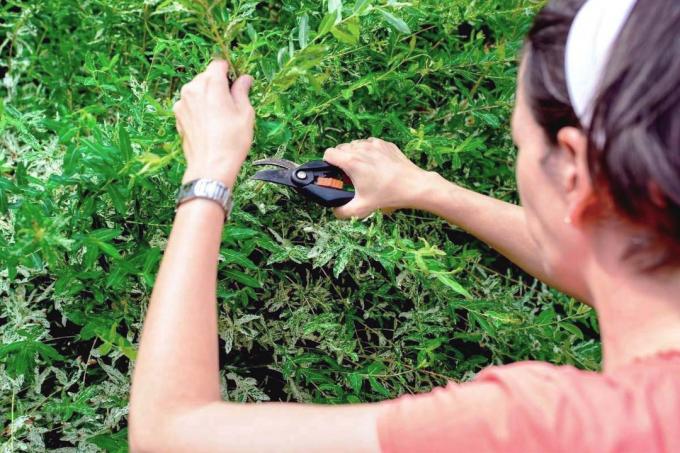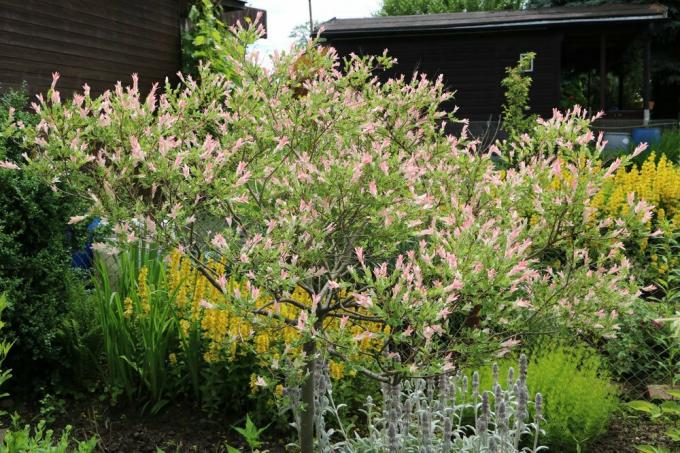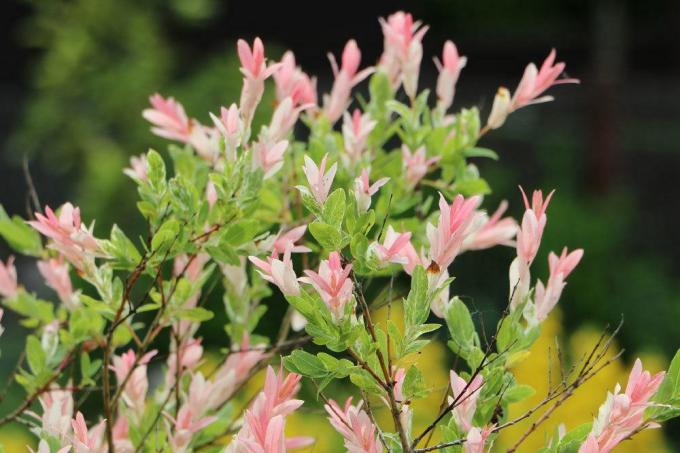
Table of Contents
- time
- Cut back the bush
- Cut back the high trunk
- Cutting back potted plants
- Cut back as cuttings
- frequently asked Questions
the Harlequin Willow is ideal for hobby gardeners to try out different cutting techniques. It grows quickly and is particularly easy on pruning. Should a cut at the harlequin willow fail, it can also tolerate a radical cut back.
In a nutshell
- Pruning harlequin willow in spring
- Radical cut to approx. 10 cm length
- always use clean cutting tools
- Always dispose of sick shoots in the residual waste
time
The ideal time for a radical pruning of a harlequin willow (Salix integra) is spring, before the buds have opened. Make sure that no frost is announced, because a fresh cut can cause the tissue to die deep into it.
Radical pruning is ideal in spring because this stimulates the willow to sprout heavily. In just a few weeks, the willow in the garden will again be an eye-catcher with many fresh shoots.
Notice: Never cut the willow in autumn or winter, as the risk of frost damage is too great. In summer, you should make smaller shaped cuts at most, as the tissue can dry out deeply here.
Cut back the bush
The shrub shape is the easiest way to train the willow. the Cut back takes place briefly above the ground and it has the advantage that you do not have to be careful to remove special shoots such as bare branches for the time being.

Instructions for pruning:
- Clean the cutting tool
- Pasture approx. Cut 10-15 cm above the ground
- Remove leaf remains from autumn
- if the shrub is too dense, cut individual branches directly above the ground
Cut back the high trunk
Radically cutting a harlequin willow tree as a standard is a bit more time-consuming. Maintaining the shape is particularly important here so that the tall trunk looks attractive later on.

Instructions for pruning tall trunks:
- Clean the cutting tool
- Shorten shoots to 10 cm
- Terminal bud must be on the outside
- at least 4 buds must remain
- sick and completely remove and dispose of bald shoots
- Completely remove overly dense or crossing shoots
No stumps may remain at the base of the tall trunk. Remove any remaining stumps with a gardener's knife, as they usually only develop poor and weak shoots that disrupt the appearance.
Cutting back potted plants
In the case of a harlequin willow in the tub, radical pruning is particularly important because it can promote the health of the plants. With this form of culture, the crown is always to be seen in relation to the root ball. If the root ball is small, the crown should also be small, otherwise the plant can no longer be adequately supplied, which leads to stunted growth.
When pruning potted plants, you should therefore never be hesitant and always shorten the shoots to the minimum length. It also helps the plants if you generally thin out the crown when pruning radically. The plants usually only develop as many new shoots as they can supply.

Tip: Repot the harlequin willow right away in spring. Also prune the roots by removing old and thick roots, which encourages the formation of fine hair roots.
Cut back as cuttings
If you're radical pruning your harlequin willow, this is the ideal time to gather cuttings for propagation. The pasture can be avoided by cuttings. However, the cuttings should always be healthy shoots.
Instructions for harvesting cuttings:
- use annual shoots
- The base should not be too lignified
- Shoot length approx. 15 cm
- at least 2 eyes must be in the ground
- Cut the base at an angle
- Stick cuttings directly into the ground
the Pastures usually take root quickly. You can transplant the young plants as early as autumn. However, refrain from subjecting them to radical pruning in the first few years, even if you want to make a topiary out of the young plants.
However, it is advisable to repot the willow over and over again in the first two to three years and then also to prune the roots regularly. This leads to better root growth, which later makes the harlequin willow more compatible with pruning.
frequently asked Questions
From the third year of standing in the garden, it is possible to cut the harlequin willow. For the shape cut, it may be necessary to radically shorten some areas so that the desired shape is more effective.
Yes, especially if the harlequin willow has been attacked by rust fungi, it is advisable to cut back heavily, even after the ideal cutting time. Depending on the season, you should protect the willow from frost in autumn and water more close to the ground in summer so that the plant recovers quickly.
No, in the case of hedges, the harlequin willow should only be subjected to radical pruning in exceptional cases. It is enough if you shorten the pasture by two thirds every two years. This ensures that, as a hedge, it offers good privacy and forms strong new shoots again.
You should have at least a pair of loppers and secateurs available for pruning. A saw may also be necessary for older trees. When pruning in late spring, larger wounds should be closed with a suitable wound closure so that fungi and bacteria do not easily penetrate through the interface be able.
